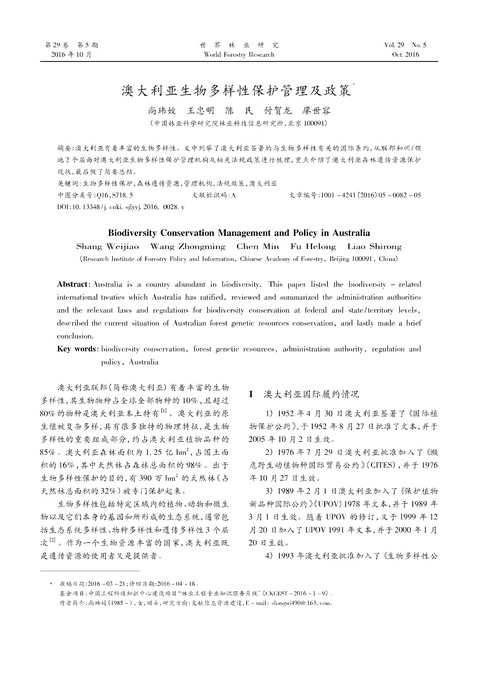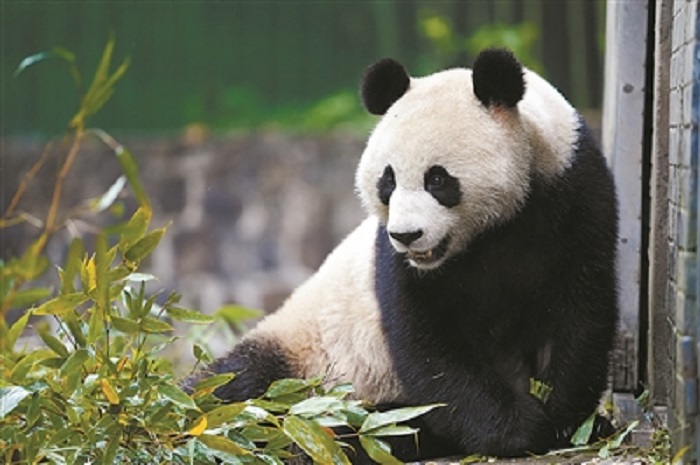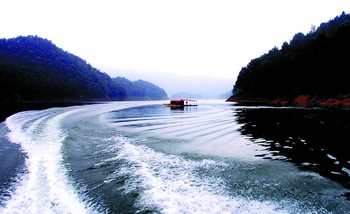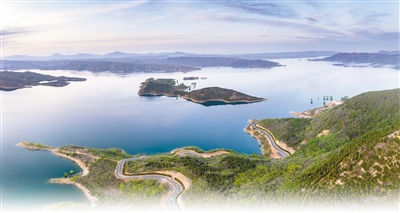
澳大利亚草地火研究进展
编号
lyqk009441


中文标题
澳大利亚草地火研究进展


作者单位
1. 西南林业大学土木工程学院,昆明 650224;
2. 云南省森林灾害预警与控制重点实验室,昆明 650224


期刊名称
世界林业研究


年份
2021


卷号
34


期号
1


栏目编号
2.0


栏目名称
各国林业


中文摘要
随着全球气候变化,尤其变暖明显,干旱天气常现,草地火频繁发生,给全球生态环境带来了巨大影响。文中从草地火形成机制、火对草地生态系统的影响、草地火时空格局及规律、草地火监测预警及预测预报、草地火管理、草地火风险评估、引燃草地火的火源等方面来阐述澳大利亚草地火研究进展,总结草地火研究存在的问题,并展望草地火未来研究的方向。研究结果能为我国草地火的预防与扑救提供参考,为我国及时调整现行草地火管理政策、改进草地火防控措施以及草地火生态、可持续经营管理提供借鉴。


基金项目
国家自然科学基金“基于火历史的滇西北亚高山主要针叶林对火的适应机制研究”(31660210);云南省农业联合面上项目“气候变化情景下的滇中地区森林可燃物动态调控机理研究”(2018FG001-055);云南省教育厅科学研究项目“景观廊道对重大森林火灾的影响机制研究”(2020Y0382)


英文标题
Grassland Fire Research in Australia


作者英文名
Zhang Wenwen, Yan Xiangxiang, Wang Qiuhua, Long Tengteng, Wei Jianheng, Gao Zhongliang


单位英文名
1. College of Civil Engineering, Southwest Forestry University, Kunming 650224, China;
2. Yunnan Key Laboratory of Forest Disaster Warning and Control, Kunming 650224, China


英文摘要
The global climate change especially the obviously warming results in frequent occurrence of drought and frequent grassland fire, which has brought a huge impact on the global ecological environment. This paper reviews the grassland fire research progress in Australia from the aspects of formation mechanism of grassland fire, the impact of fire on grassland ecosystem, space-time pattern and law of grassland fire, the grassland fire monitoring, early warning and forecasting, grassland fire management, fire risk assessment and fuels to ignite grassland fire, concludes the existing problems in the grassland fire research and prospect the future research direction of grassland fire. This research would provide a basis for the prevention and suppression of grassland fire in China and also provide the reference for adjusting the current fire management policies, improving the prevention and control measures of grassland fire and enhancing the sustainable management of grassland.


英文关键词
grassland fire;ecological environment;fire early warning;fire risk assessment;Australia


起始页码
113


截止页码
118


投稿时间
2020/4/1


最后修改时间
2020/8/22


作者简介
张文文,女,河南周口人,硕士生,主要从事森林防火研究,E-mail:zww819794389@163.com


通讯作者介绍
王秋华,男,福建长汀人,教授,E-mail:qhwang2010@swfu.edu.cn


E-mail
王秋华,qhwang2010@swfu.edu.cn


分类号
S762


DOI
10.13348/j.cnki.sjlyyj.2020.0091.y


参考文献
[1] 邹志翀, 冷红. 澳大利亚森林火灾风险相关研究进展及其启示[J]. 国际城市规划,2018,33(3):62-72.
[2] GLASSPLOOL I J, EDWARDS D, AXE L. Charcoal in the Silurian as evidence for the earliest wildfire[J]. Geology, 2004, 2(5):381-384.
[3] PAUSAS J G, KEELY J E. A burning story: the role of fire in the history of life[J]. BioScience, 2009, 59(7):593-601.
[4] 张树昌, 任利娥. 草地火灾生成原因及火管理系统的研究与应用[J]. 养殖技术顾问,2012(9):236.
[5] 岳超, 罗彩访, 舒立福, 等. 全球变化背景下的野火研究进展综述[J]. 生态学报,2020,40(2):1-17.
[6] 王秋华, 舒立福, 俞新水. 云南松林飞火形成机制的研究[J]. 安徽农业科学,2011,39(4):2110-2112.
[7] BALEŽENTIENÉ L, UŽUPIS A. Fuzzy TOPSIS applied for evaluation of mitigation strategies for greenhouse gas emissions from abandoned grassland[J]. Research Gate, 2012, 75(3):242-249.
[8] CHUVIECO E, AGUADO I, YEBRA M, et al. Development of a framework for fire risk assessment using remote sensing and geographic information system technologies[J]. Ecological Modelling, 2010, 221(1):46-58.
[9] GOSZ R J, GOSZ J R. Species interactions on the biome transition zone in New Mexico: response of blue grama (Bouteloua gracilis) and black grama (Bouteloua eripoda) to fire and herbivory[J]. Journal of Arid Environments, 1996, 34(1):101-114.
[10] PAUSAS J G, BRADSTOCK R A, KEITH D A, et al. Plant functional traits in relation to fire in crown-fire ecosystems[J]. Ecology, 2004, 85(4):1085-1100.
[11] BROCKWAY D G, GATEWOOD R G, PARIS R B. Restoring fire as an ecological process in short grass prairie ecosystems: initial effects of prescribed burning during the dormant and growing seasons[J]. Journal of Environmental Management, 2002, 65(2):135-152.
[12] GUEVARA J C, STASI C R, WUILLOUD C F, et al. Effects of fire on rangeland vegetation in south-western Mendoza plains (Argentina): composition, frequency, biomass, productivity and carrying capacity[J]. Journal of Arid Environments, 1999, 41(1):27-35.
[13] STAVER A C, ARCHIBALD S, LEVIN S A. The global extent and determinants of Savanna and forest as alternative Biome States[J]. Science, 2011, 334(6053):230-232.
[14] ALDERSLEY A, MURRAY S J, CORNELL S E. Global and regional analysis of climate and human drivers of wildfire[J]. Science of the Total Environment, 2011, 409(18):3472-3481.
[15] LANGMANN B, DUNCAN B, TEXTOR C, et al. Vegetation fire emissions and their impact on air pollution and climate[J]. Atmospheric Environment, 2009, 43(1):107-116.
[16] LAMONT B B, HE T H. Fire-proneness as a prerequisite for the evolution of fire-adapted traits[J]. Trends in Plant Science, 2017, 22(4):278-288.
[17] SHAY J, KUNEC D, DYCK B. Short-term effects of fire frequency on vegetation composition and biomass in mixed prairie in south-western Manitoba[J]. Plant Ecology, 2001, 155(2):157-167.
[18] PELLEGRINI A F A, ANDEREGG W R L, PAINE C E T, et al. Convergence of bark investment according to fire and climate structures ecosystem vulnerability to future change[J]. Ecology Letters, 2017, 20(3):307-316.
[19] EKKIOTT K J, HENDRICK R L, MAJOR A E, et al. Vegetation dynamics after a prescribed fire in the southern Appalachians[J]. Forest Ecology and Management, 1999, 114(2/3):199-213.
[20] EDWARDS A, HAUSER P, ANDERSON M, et al. A tale of two parks: contemporary fire regimes of Litchfield and Nitmiluk National Parks, monsoonal northern Australia[J]. International Journal of Wildland Fire, 2001, 10(1):79-89.
[21] KING K, CARY G, GILL A M, et al. Implications of changing climate and atmospheric CO2 for grassland fire in south east Australia: insights using the GRAZPLAN grassland simulation model[J]. International Journal of Wildland Fire, 2012, 21(6):695-708.
[22] ROGERS B M, SOJA A J, GOULDN M L, et al. Influence of tree species on continental differences in boreal fires and climate feedbacks[J]. Nature Geoscience, 2015, 8(3):228-234.
[23] STAMBAUGH M C, DEY D C, GUYETTE R P, et al. Spatial patterning of fuels and fire hazard across a central U.S. deciduous forest region[J]. Landscape Ecology, 2011, 26(7):923-935.
[24] YUE C, CIAIS P, CADULE P, et al. Modelling the role of fires in the terrestrial carbon balance by incorporating SPITFIRE into the global vegetation model ORCHIDEE: Part 1: simulating historical global burned area and fire regimes[J]. Geoscientific Model Development, 2014, 7(6):2747-2767.
[25] MIREIA, CASALS P, JOAN R. Temporal changes in soil organic C under Mediterranean shrublands and grasslands: impact of fire and drought[J]. Plant and Soil, 2011, 338(1/2):289-300.
[26] WANG J, LI Y, CHEN P, et al. Design and research of fire early warning system based on topological structure for forest[C]. Third International Workshop on Advanced Computational Intelligence, IEEE, 2010.
[27] WANG M, LIU H, CHEN F, et al. Forest fire warning system based on GIS and WSNs[C]. International Conference on Advanced Information Technology & Sensor Application, IEEE, 2015.
[28] 翟继强, 王克奇. 无线传感器网络在林火监测中应用[J]. 东北林业大学学报,2013,41(8):126-129, 149.
[29] PRICE O F, GORDON C E. The potential for LIDAR technology to map fire fuel hazard over large areas of Australian forest[J]. Journal of Environmental Management, 2016, 181:663-673.
[30] 姜莉, 玉山, 乌兰图雅, 等. 草原火研究综述[J]. 草地学报,2018,26(4):791-803.
[31] 郭平, 孙刚, 周道玮, 等. 草地火行为研究[J]. 应用生态学报,2001,12(5):746-748.
[32] FRANGIEH N, MORVAN D, MERADJI S, et al. Numerical simulation of grassland fires behavior using an implicit physical multiphase model[J]. Fire Safety Journal, 2018, 102:37-47.
[33] 张正祥. 基于地理信息系统和遥感的草地火状况研究[D]. 长春: 东北师范大学, 2010.
[34] LIBRARY L. Bulletin of the transilvania university of brasov, series A1[J]. Gastroenterologia Japonica, 2014, 5(1):53-54.
[35] WALLACE G. A numerical fire simulation-model[J]. International Journal of Wildland Fire, 1993, 3(2):111-116.
[36] 王新岩, 金森. 美国国家火险等级系统中火险系统的原理与方法[J]. 森林防火,2010(1):58-62.
[37] LUKE R H, MCARTHUR A G. Bushfires in Australia[R]. Australia: CSIRO Division of Forest Research, 1978.
[38] ROTHERMEL R C. A mathematical model for predicting fire spread in wildland fuels[C] //USDA Forest Service general technical report, 1972: 115.
[39] ADAB H, KANNIAH K D, SOLAINMANI K, et al. Modelling static fire hazard in a semi-arid region using frequency analysis[J]. International Journal of Wildland Fire, 2015, 24(6):763-777.
[40] VLIEGHER B. Risk assessment for environmental degradation caused by fires using remote sensing and GIS in a Mediterranean region (south-Euboia, central Greece)[C]. International Geoscience & Remote Sensing Symposium, IEEE, 2002.
[41] GUO F T, WANG G Y, SU Z W, et al. What drives forest fire in Fujian, China?: evidence from logistic regression and random forests[J]. International Journal of Wildland Fire, 2016, 25(5):505-519.
[42] BUTRY D T, PRESTEMON J P, THOMAS D S. Investigation of the decline in reported smoking-caused wildfires in the USA from 2000 to 2011[J]. International Journal of Wildland Fire, 2014, 23(6):55-62.
[43] SATOH K, ZHONG Y L, YANG K T. Study of forest fire initiation due to lighted cigarette--measurement and observation of flaming probability of dried leaves[J]. Report of National Research Institute of Fire & Disaster, 2003, 19(1):146-153.
[44] 张运林, 张恒, 金森. 基于Logistic回归的烟头点燃红松松针概率研究[J]. 中南林业科技大学学报,2015,35(9):45-51.
[45] BUNTING S C, WRIGHT H A. Ignition capabilities of non-flaming firebrands[J]. Journal of Forestry-Washington, 1974, 72(10):646-659.
[46] GANTEAUME A, GUIJARRO M, JAPPIOT M, et al. Laboratory characterization of firebrands involved in spot fires[J]. Annals of Forest Science, 2011, 68(3):531-541.
[47] GANTEAUME A, MARIELLE J, CORINNE L M, et al. Effects of vegetation type and fire regime on flammability of undisturbed litter in Southeastern France[J]. Forest Ecology and Management, 2011, 261(12):2223-2231.
[48] GANTEAUME A, LAMPINMAILLET C, GUIJARRO M, et al. Spot fires: fuel bed flammability and capability of firebrands to ignite fuel beds[J]. International Journal of Wildland Fire, 2009, 18(8):951-969.
[49] PEREZ P, VEGA J A, FONTURBEL M T, et al. Capability of ignition of some forest firebrands[C]// Proceedings of IV International Conference on Forest Fire Research 2002 Wildland Fire Safety Summit, Luso, Coimbra, Portugal, 2002: 18-23.
[50] WRIGHT J G. Forest-fire hazard research as developed and conducted at the Petawawa Forest Experiment Station[J]. Research, 1967, 9(1):123-124.
[51] MANZELLO S L, CLEARY T G, SHIELDS J R, et al. Ignition of Mulch and grasses by firebrands in wildland-urban interface fires[J]. International Journal of Wildland Fire, 2006, 15(3):427-431.
[52] ELLIS P E M. The likelihood of ignition of dry-eucalypt forest litter by firebrand[J]. International Journal of Wildland Fire, 2015, 24(2):225-235.
[53] ANDERSEN A N, COOK G D, CORBETT L K, et al. Fire frequency and biodiversity conservation in Australian tropical savannas: Implications from the Kapalga fire experiment[J]. Austral Ecology, 2005, 30(2):155-167.
[54] WATSON P J, PENMAN S H, BRADSTOCK R A. A comparison of bushfire fuel hazard assessors and assessment methods in dry sclerophyll forest near Sydney, Australia[J]. International Journal of Wildland Fire, 2012, 21(6):755-763.


发布日期
2020-08-27


PDF全文
浏览全文


-
相关记录
更多
 打印
打印







